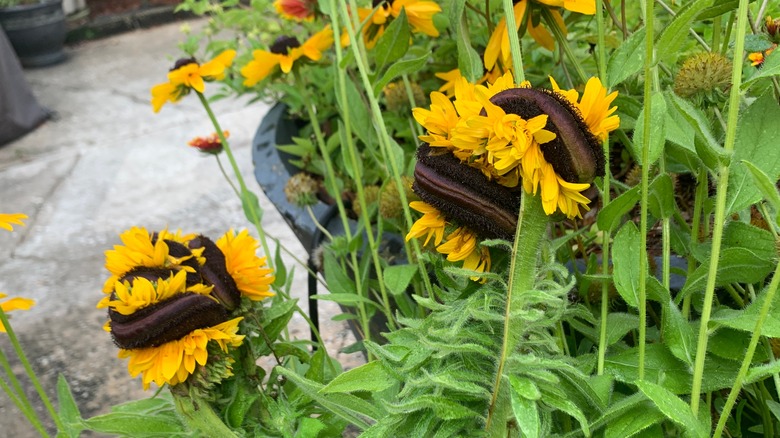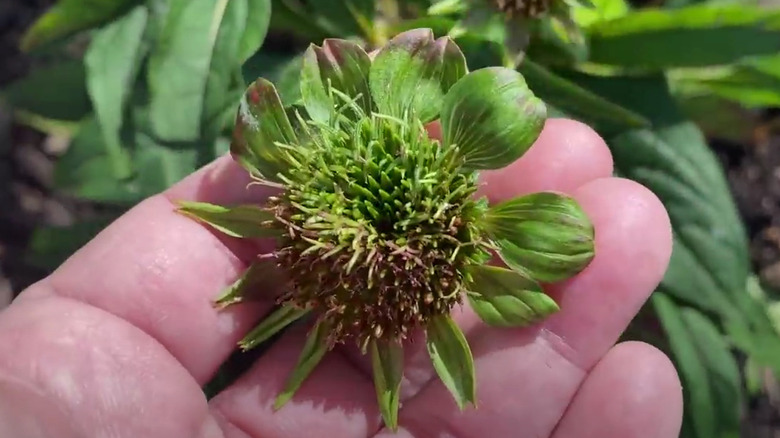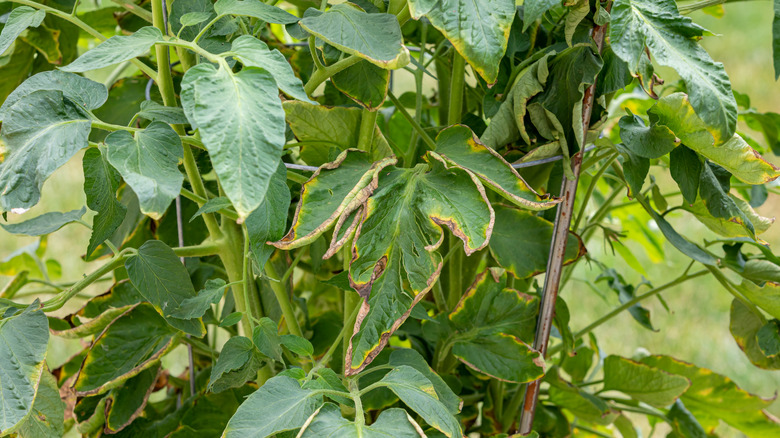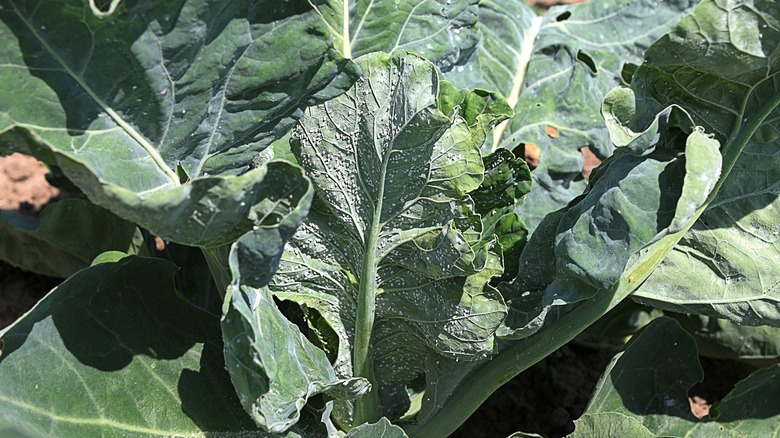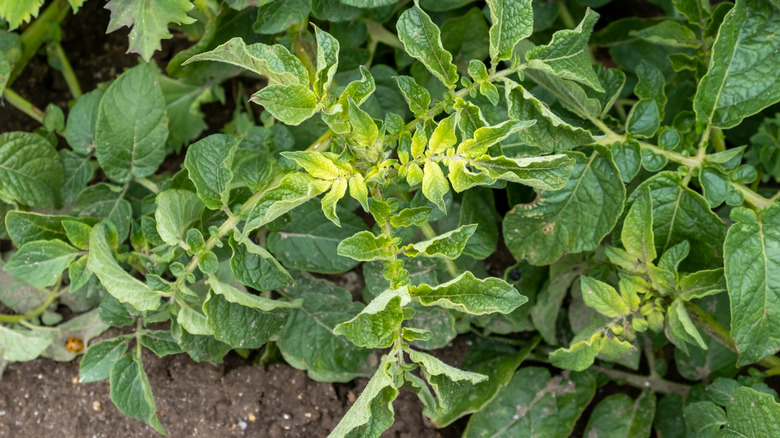Why Your Plants Are Growing In Abnormally (And What To Do About It)
We may receive a commission on purchases made from links.
As you carefully watch over your garden and landscape for healthy growth throughout the season, you might see some concerning changes. Some signs of a problem may be minor, appearing as curling leaves or slow growth. Other symptoms of major problems are abnormal bloom development, like new stems growing from the tops of flowers, making them look like something from outer space. It can be difficult to tell what's causing abnormal growth on your plants, but some manageable issues include pest infestations and nutrient deficiencies, while more complex problems involve the spread of bacteria and herbicide drift.
When you're facing a problem in your garden, don't panic. Most abnormal growth is due to something simple. For example, pests are much more common than phytoplasma; however, when you do positively identify a problem, you'll need to act fast to ensure it doesn't continue. Fertilization, pest management, and protection from extreme environmental changes are simple solutions, but in the worst-case scenarios, you may have to remove some beloved plants.
Fascinating fasciation
If you've ever done a double take when looking at your plant and wondered, "What is going on here?", you may be dealing with fasciation. There is no single cause for fasciation since it can happen as a result of genetic issues, fungal problems, bacteria, or other reasons. While there can be multiple causes, the symptoms of fasciation are consistent. This abnormal growth occurs primarily on stems and blooms, which are not limited to any specific plant family. Fasciation can show up just about anywhere, presenting with flattened, ribbon-like stems that look like they've been smashed by a pastry roller. Sometimes those stems grow sideways or in a spiral. While this is a blanket term, the good news is that it can usually be resolved by pruning off the abnormal growth, allowing the rest of the plant to grow normally.
In blooms, this issue presents as flowers that are supposed to be round, like daisies or dandelions, growing elongated with an oval shape. Another presentation is when it looks like two or more flowers are squished together as one bloom. Fasciation shows up a little differently in each plant, but the general symptoms are the same, and you'll know it when you see it. Remove the abnormal growth and if it shows up again, the problem may be something more extensive.
Aster yellows
Aster yellows might sound kind of pleasant, like a field of sunny hues, but it is bad news when you find signs of this bacterium in your garden. Phytoplasma, a single-celled organism that lacks a cell wall, exists in the aster leafhopper after it consumes the tissue of an infected plant. As that insect moves between your greenery, it feasts on the foliage, spreading this nasty little pathogen around the garden. According to the University of Wisconsin-Madison, aster yellows affects over 300 species of plants, including, but not limited to, those in the aster family like purple coneflower and marigolds. This devastating problem can also show up in vegetable gardens.
Aster yellows presents differently, depending on the plant. If the aster leafhopper gets to them early, their growth may be stunted, while more mature plants start showing discolored leaves in yellow, white, or purple hues. Flowers also open abnormally, lacking their desired color. Perhaps the most bizarre symptom of aster yellows is on the blooms of affected plants, which appear to grow small stems topped with clusters of smaller flowers.
Sadly, there is no cure for aster yellows. If you discover this disease on your annual or perennial plants, they should be removed and discarded (not composted!) immediately. To further prevent the problem, grow plants that are not susceptible to this disease. The Missouri Botanical Garden recommends planting impatiens or salvia, which can be pruned for endless blooms all summer.
Nutrient deficiencies
The appearance of nutrient deficiencies can look scary in your garden, but luckily, this is one problem that usually has an easy fix: compost and fertilizer. Sometimes nutrient deficiencies are temporary. When the soil is saturated due to excessive rainfall or is extremely dry due to drought, your plants may start showing signs of yellowing or curling leaves, and some fruits on tomatoes, peppers, and squash could end up with blossom-end rot. Once the moisture in the soil balances out, those nutrients become bioavailable again, and your plants should recover.
If the issue is actually soil that is too lean to support your plants, you have a few options. First, it's best to know what nutrients are in your soil by getting a DIY soil test, like this one on Amazon. Different deficiencies have slightly different presentations, so knowing exactly what nutrients your soil is lacking will help you know what you need to add. Applying an inch or two of compost to the surface of the soil will help improve the soil over time, while fertilizer offers nutrients right away. If your plants are really struggling, a foliar fertilizer, like fish emulsion or any water-soluble option can give them a quick boost.
Pesky pests
The aster leafhopper isn't the only one who can cause plants to grow abnormally, although most of the time, pest damage shows up as physical damage to the plants, like holes in the leaves or leaf curling. When your plants are growing strangely due to pests, there are a few things to look for. In the case of pests, you'll usually see the damage before you see the guilty buggers, so when you notice that your plant's leaves don't look healthy, inspect the undersides. You may find tiny insects like aphids, spider mites, or whiteflies. Many of these tiny bugs have sucking mouthparts that remove the moisture from the leaves, causing them to curl, which then leads to discoloration.
The hard part of dealing with pest damage is identifying the bugs causing the problem. Once you know that, find the best organic solution or use pesticides as a last resort. If you do opt for pesticides, always follow the safety precautions on the label. Many tiny pests can be dealt with by spraying the top and bottom of the leaves with the jet setting on a hose-end sprayer. This knocks them off the plant and drowns them. It may take a few tries, but this is certainly the cleanest method of pest control.
Environmental issues
When you notice that the growth on your plants looks abnormal, but it doesn't fit into the above categories, the problem may be environmental. Extended heat and drought can cause growth and flower production to stall on plants, and relentless sun can scald the leaves. Don't worry if you need to water during the day, though, because watering on a sunny day won't hurt your plants. If you do notice sunscald or other sun and heat-related issues, installing shade cloth can help your plants get through the worst of the summer stressors by blocking some UV rays and cooling the soil.
Herbicides in manure compost or drift are often mistaken for aster yellows, so if you aren't sure what the problem is, contact your local extension service for help growing a healthy, gorgeous garden. In fact, this is good advice for any problem you have in your garden. If you're not sure what's causing your plants to grow abnormally, give your local office a call, and they can help you through the process of identification and resolution.

